A guide to basic accounting for manufacturing businesses
This guide covers basic manufacturing accounting terms you should know and what to look for when choosing an accounting software.
Lean manufacturing is all about minimizing waste while maximizing productivity.
It is a practice first initiated by Toyota but has influenced manufacturing for decades, particularly the automobile industry.
Since then, many other industries have come to regard removing waste from their processes as beneficial to the bottom line.
As you streamline manufacturing processes to eliminate waste and shorten the time between receiving and orders, you can also streamline your accounting processes and use them to gather relevant operating information.
This provides valuable feedback on your manufacturing and inventory processes.
Without adapting accounting for manufacturing processes, especially as it increases in complexity as your business grows, it may be difficult to understand how changes in your operations are making a difference to your manufacturing bottom line.
To reduce the costs of doing business, you must understand first where your production costs lie.
It helps if you break down product costs from all the contributing factors that play a part in the cost of the manufacturing product – not only for each item but for all the activities that add cost to the end product.
If you want to refine your production process and automate aspects of your business, accurate costing information helps you identify wasteful costs passed on to the customer or absorbed within the company.
This is all in aid of increasing your revenue and your profit margins.
Manufacturing cost terms to understand
You need to think beyond profit and loss to manufacturing costs such as the costs of materials, plus the cost to convert these materials into products.
This is necessary, for example, to understand how you should be pricing your product and how to achieve or exceed your set profit margins.
In a manufacturing business, there are some important terms you need to understand when it comes to calculating the costs of manufacturing your product, as well as the amount of inventory you hold.
Direct materials
Direct material (or raw material) inventory is a calculation of all the materials your manufacturing business is using to make your product – all the materials consumed or identified with your product.
Very often, this is listed in a bill of materials, which itemizes quantities and costs the materials used in your product.
In process manufacturing, such as food and beverage or chemicals, the bill of materials is known as a production recipe.
Direct labor costs
Direct labor is the value given to the labor that produces your goods, such as machine or assembly line operators.
Generally, this includes the cost of the regular hours, overtime, and relevant payroll taxes.

Discover New Opportunities
In this program, you'll gain the expertise needed to advance you into a senior-level position, manage an accounting department, or pursue an advanced degree in accounting.
for all business, commercial, industrial, government and professional fields. Such training is essential in today’s competitive business environment and a world of increasing international trade and globalisation.
Manufacturing overheads
Along with direct materials and direct labor, you must include the cost of manufacturing overhead to ensure you get the right valuation when it comes to inventory and selling price.
Manufacturing overheads might include the costs for powering a factory’s equipment and personnel not directly involved in producing the product.
Work-in-process goods
As part of the manufacturing process, your business is likely to have items in production that have not yet been completed.
This will be an accumulation of the money you have spent on direct materials, direct labor costs, and manufacturing overheads on each work-in-process item in your inventory.
Finished goods
This is the cost associated with the goods you have completely ready to sell to your customers.
You would also add the cost of storing these finished goods and other associated expenses.
On your typical manufacturing balance sheet, you should have raw materials, work in process, and finished goods as part of your inventory calculation.
You will also want a periodic or perpetual inventory system to track how many products you have in your production line at any one time.
Production costing methods
When it comes to accounting, you need the right costing method to help you achieve higher profitability. Accounting software for manufacturers may offer different costing methods. Here are the ones that you should be aware of:
Standard costing
Standard costing is an accounting system where you establish standard rates for materials or labor used in production or inventory costing. By doing this, you can work out the labor and material costs to produce a single unit of your product.
Having these standards allows you to detect variances that can be analyzed, allowing trends to be spotted, and enabling you to make the right adjustments to pricing. If you are spending more on manufacturing the product than necessary, you will not meet your income targets.
Look at where the inefficiencies are in the production process and where the waste is coming from, adjusting the pricing if required. Standard costing is useful if you are making similar products or large quantities of a specific product.
Job costing
Job costing, also known as variable costing, is better if you manufacture to order or focus on a small amount of units. For example, this could include a custom-built machine or a small batch of products.
This accounting system allows you to work out the individual cost of manufacturing for a product and apply the right mark-up to get the project margin you desire.
You might look at each project in detail – down to costs, materials, and overhead. It is particularly popular in construction.
Activity-based costing
This is a costing method that differs from job costing in that it incorporates more indirect costs, such as resource consumption.
It can help you hone which products are profitable and spot opportunities to drive better results for your existing products.
This might be good if you have a complex product mix.
Inventory valuation
Inventory management is crucial for a manufacturer.
At the end of an accounting period, at the end of the financial year, you will want to have a value associated with the number of goods in your inventory.
Valuing your inventory will help establish the costs of goods sold and how much profit you are making.
Having a shortage or excess inventory directly affects the production and profitability of your manufacturing business.
Inventory is continually being sold and restocked, so you may need to make a cost flow assumption.
There are four accepted ways to value inventory.
First in, first-out (FIFO)
Many manufacturers use the ‘first-in, first-out (FIFO)’ method, where products are sold in the order they are added to inventory.
A popular way of costing inventory; this could work for businesses that have products with a shelf life.
Last in, last out (LIFO)
This inventory valuation method operates under the assumption that the final product added to a company’s inventory is the first one sold. Fewer manufacturers use this method.
Average cost
This is a common accounting method that uses a weighted average of all products to determine and track inventory.
Average costing is useful in situations where it is difficult to assign costs to specific or individual products.
Specific identification
This accounting method tracks individual items of inventory, which is useful if you can identify each item with, for example, a serial number or RFID tag.
This can produce a higher degree of accuracy, but many manufacturers are unlikely to have items that have a unique identification.
This is better for high-value items that need differentiation, rather than interchangeable items.
Everything you need,
totally goals
Perfect Restaurant Business Plan is a complete guide that explains the process of business goals.
Restaurant Management covers the practical components for successfully overseeing a restaurant or realizing a restaurant concept.

What you should look for in your manufacturing accounting software
Without accurate, timely, and quality information, it won’t be easy to understand what is happening in your business.
As a manufacturer, you must always be on top of materials and other associated costs to correctly price your finished items.
At the same time, you need to consider external market factors affecting your business and industry.
It would help if you had a manufacturing software solution that allows you to deal with the extra complexity of calculating inventory and the cost of your manufacturing goods.
This software can be used to extract data and analyze trends, improve efficiency, and make the best business decisions.
Your manufacturing accounting software should also help you keep compliant with regulations and the tax laws of the countries you have a business in.
Often, manufacturers invest in an all-in-one solution, which handles other tasks away from finances, such as planning and production.
This is known as Enterprise Resource Planning (ERP). Ideally, data should move freely between production lines and the back office, meaning you have accurate real-time data.
Features found in accounting software such as inventory management can help you optimize the way you use inventory, such as providing alerts when your stock needs replenishing.
It is crucial when understanding raw materials, work-in-process, and finished goods.
It will avoid a situation where you have too much inventory (which costs money) or, even worse, not enough inventory, where you cannot fulfill the requirements of your customers.
Unlock the secrets to financial success in manufacturing
Manufacturing
A manufacturing corporation must coordinate an unending amount of work, from putting together the components for manufacturing to shipping the finished product to the market. To ensure the quality of each product, the conversion of raw materials into final goods must be effectively monitored or managed. If all of these processes are managed manually, it will be quite taxing on you and take up a significant portion of your working day. In order to ensure that their consumers are receiving high-quality products, the company will benefit from having an effective system for managing all of these procedures related to manufacturing orders.
A business may effectively manage manufacturing orders, bills of materials, and work centers, and track all manufacturing operations at every level with the use of the Odoo17 ERP system. Odoo 17 is wholly reliable for the efficient management of job orders. With the specialized module, arranging and planning each stage of manufacture is now simpler.
We will examine the Manufacturing module for Odoo 17 in-depth in this chapter.
You will arrive at the Overview window of the work centers in Odoo17 when you access the Manufacturing module from the main dashboard of Odoo17. As seen in the image below, this platform will display all configured work centers in your system.

The work centers can be managed directly from this dashboard. You can keep track of all the work orders for the specific work center by using the Work Orders button. You can use the little monitor icon for this. You can access additional operating tools by clicking on the three dots located in the upper right corner of each work center tab, as illustrated below. You can take steps to plan orders and maintenance using this menu.
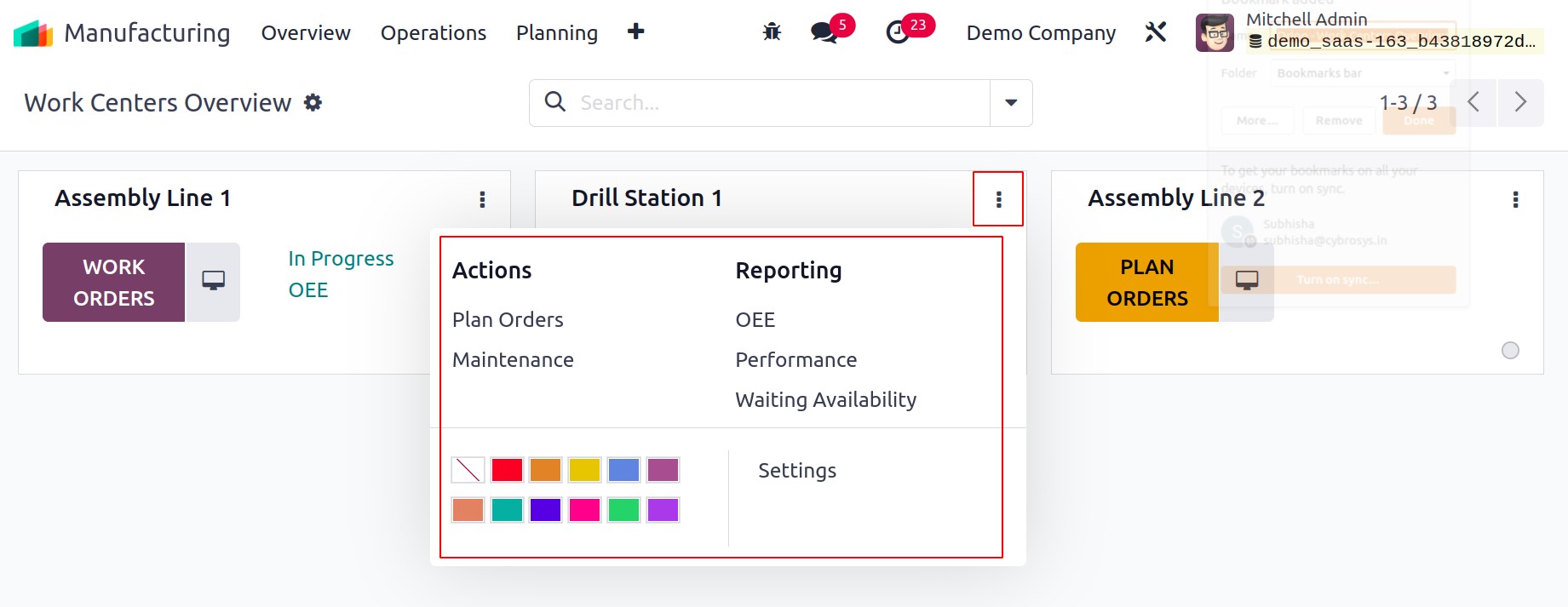
Additionally, it displays buttons for creating reports on performance, waiting availability, and overall equipment efficiency.
To make the necessary changes to the work center's configuration, use the Settings option. You can see a tiny red dot on the associated work center if the work center is obstructed. There are no active work orders at the specific work center, as indicated by the yellow color of the PLAN ORDERS.
Manufacturing Orders
To produce a flawlessly finished product, several activities are included in a production order. All of these procedures can be specified as Work Orders when configuring a manufacturing order in the Odoo17 Manufacturing module. In Odoo17, you may generate production orders to accomplish this. The Manufacturing Orders option may be found in the Manufacturing module's Operations menu. Odoo17 will open the list of manufacturing orders produced in this module when you select this option. For this platform, you can choose from List, Kanban, Calendar, Pivot, and Graphical views.
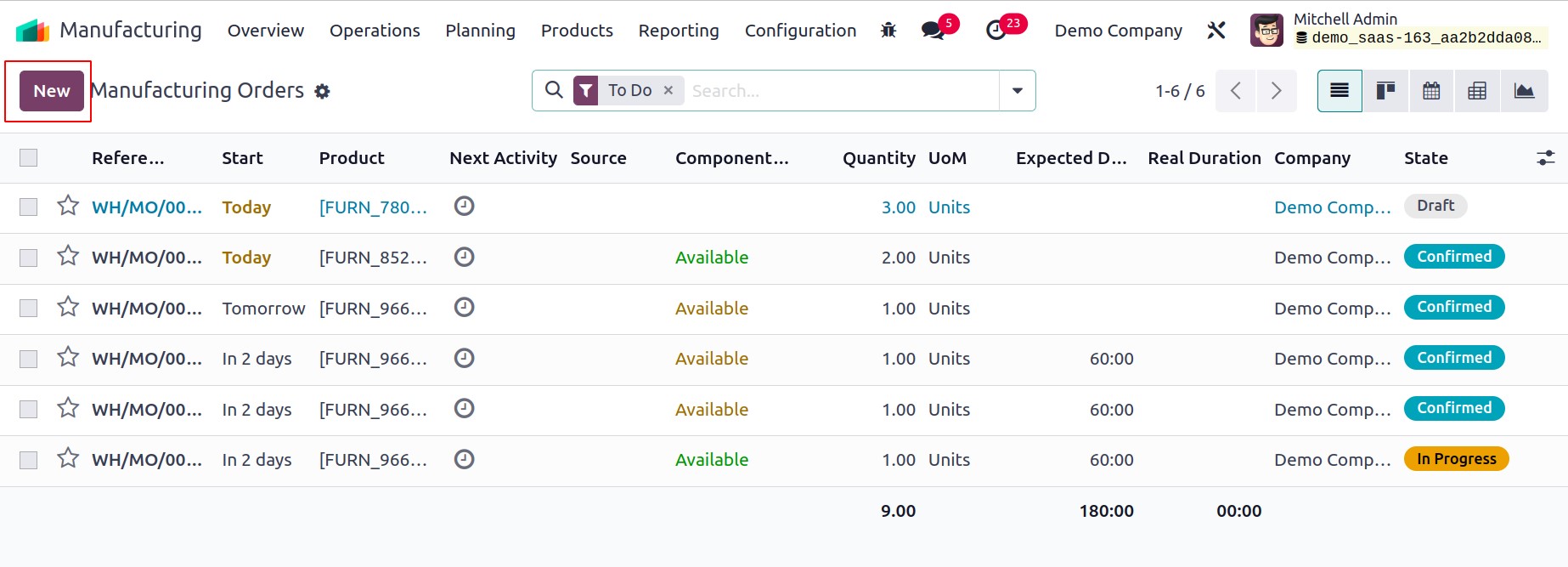
The list's preview displays information about the manufacturing orders, including the Reference, Scheduled Date, Product, Next Activity Source, Component Status, Quantity, UoM, Expected Duration, Real Duration, Company, and State. Different colors will be used to represent the state.
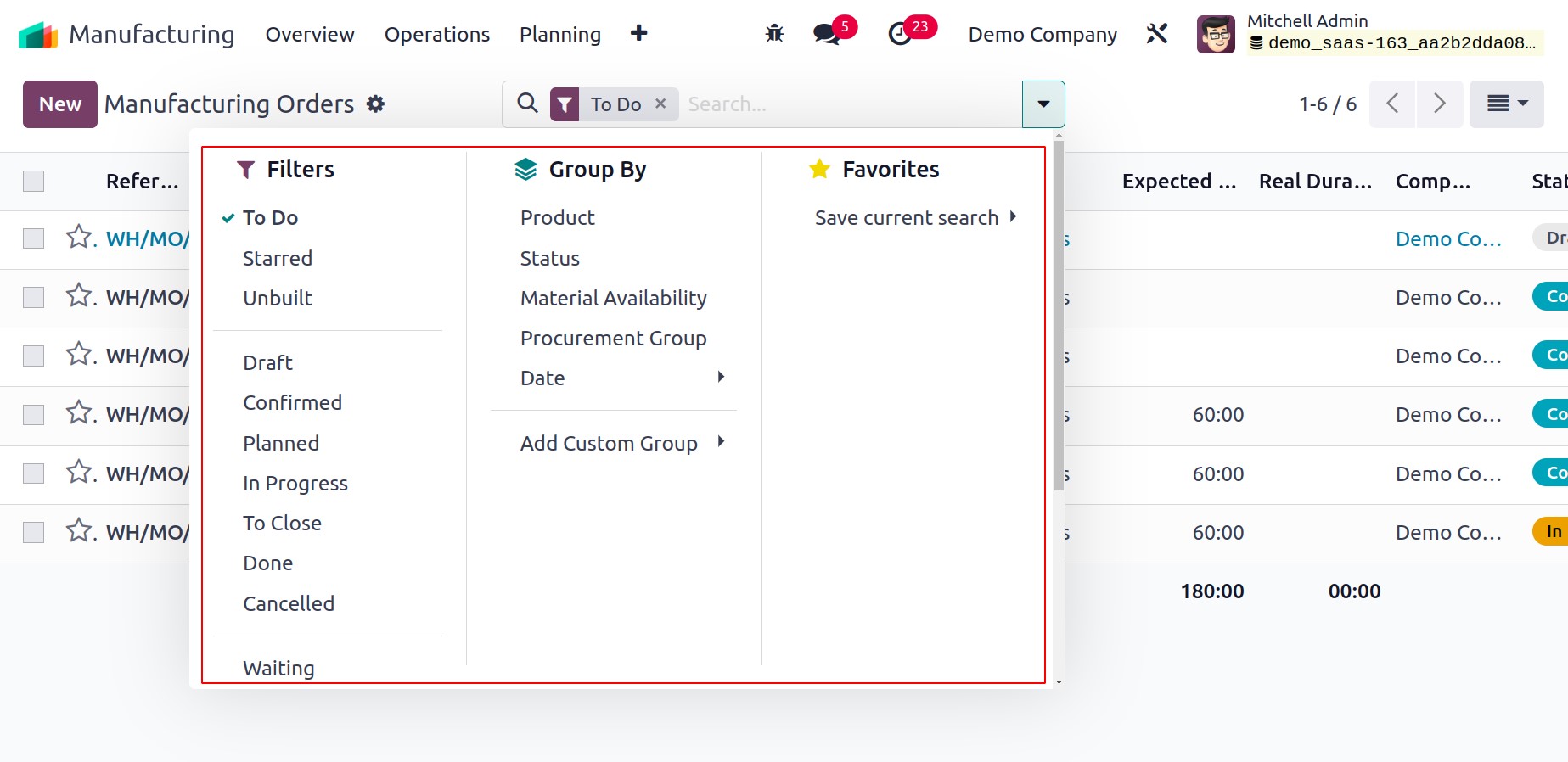
The following filters are available as default selections: To Do, Starred, Unbuilt, Draught, Confirmed, Planned, In Progress, To Close, Done, Canceled, Waiting, Ready, Planning Issues, Scheduled Date, and Warning. Based on Product, Status, Material Availability, Procurement Group, and Scheduled Date, the data is segmentable. Both the Filters and Group By choices come with the customization option.
By selecting the New button, a new production order can be created. The following form view will then come up.
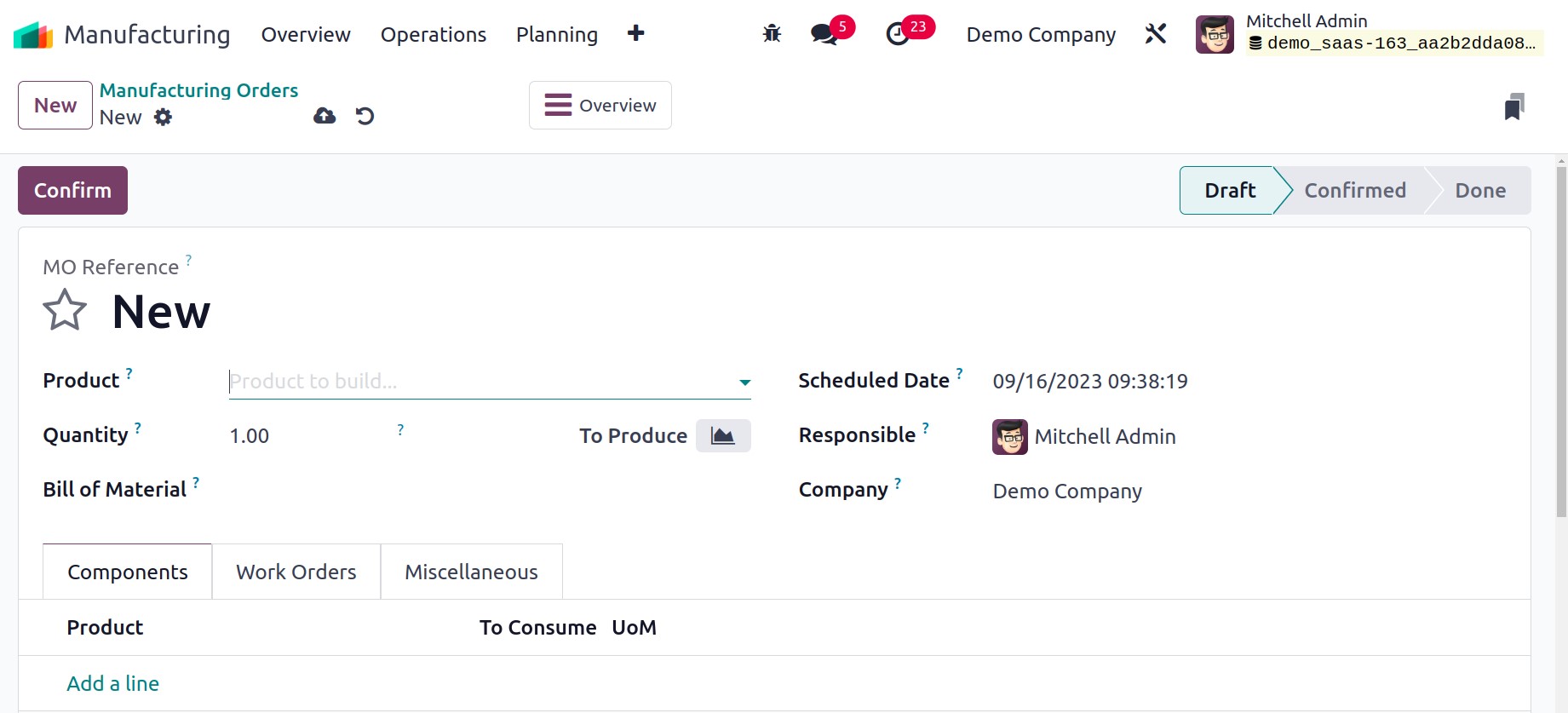
You can enter the name of the product you want to make in the Product section. You are able to include the components needed to make a final product in the "Bill of Materials" column. Give the quantity of the product you intend to generate in the Quantity area. The Scheduled Date option allows you to choose the day you intend to begin the product's production. In the Responsible field, designate the Company and an employee who will be responsible for keeping an eye on the progress of this manufacturing order.
You can list each component needed to make this product one at a time in the Components tab by using the Add a Line button. The From field will have access to the components' locations. If you intend to outsource the manufacturing operations, then that location will be a partner location. The number of products from an inventory perspective will be displayed in the To Consume field. Mention the UoM of the individual components along with this.
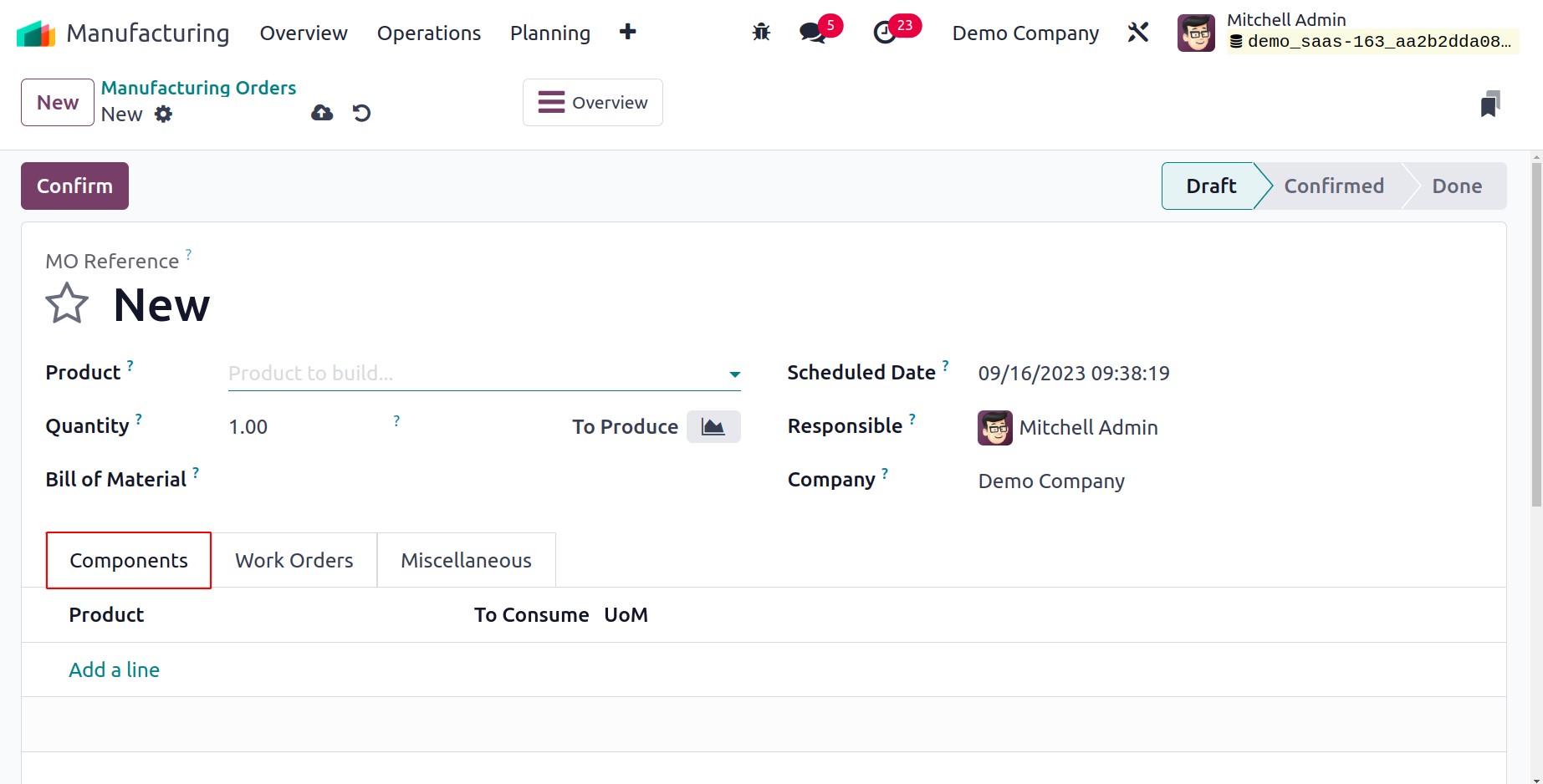
The Work Orders tab can be used to organize the production activities for each work center. You can add the Operation, Work Centre, Product, Quantity, Scheduled Starting Date, and Expected Duration using the Add a Line button. The Real Duration will automatically update after you start the process and confirm the manufacturing order.
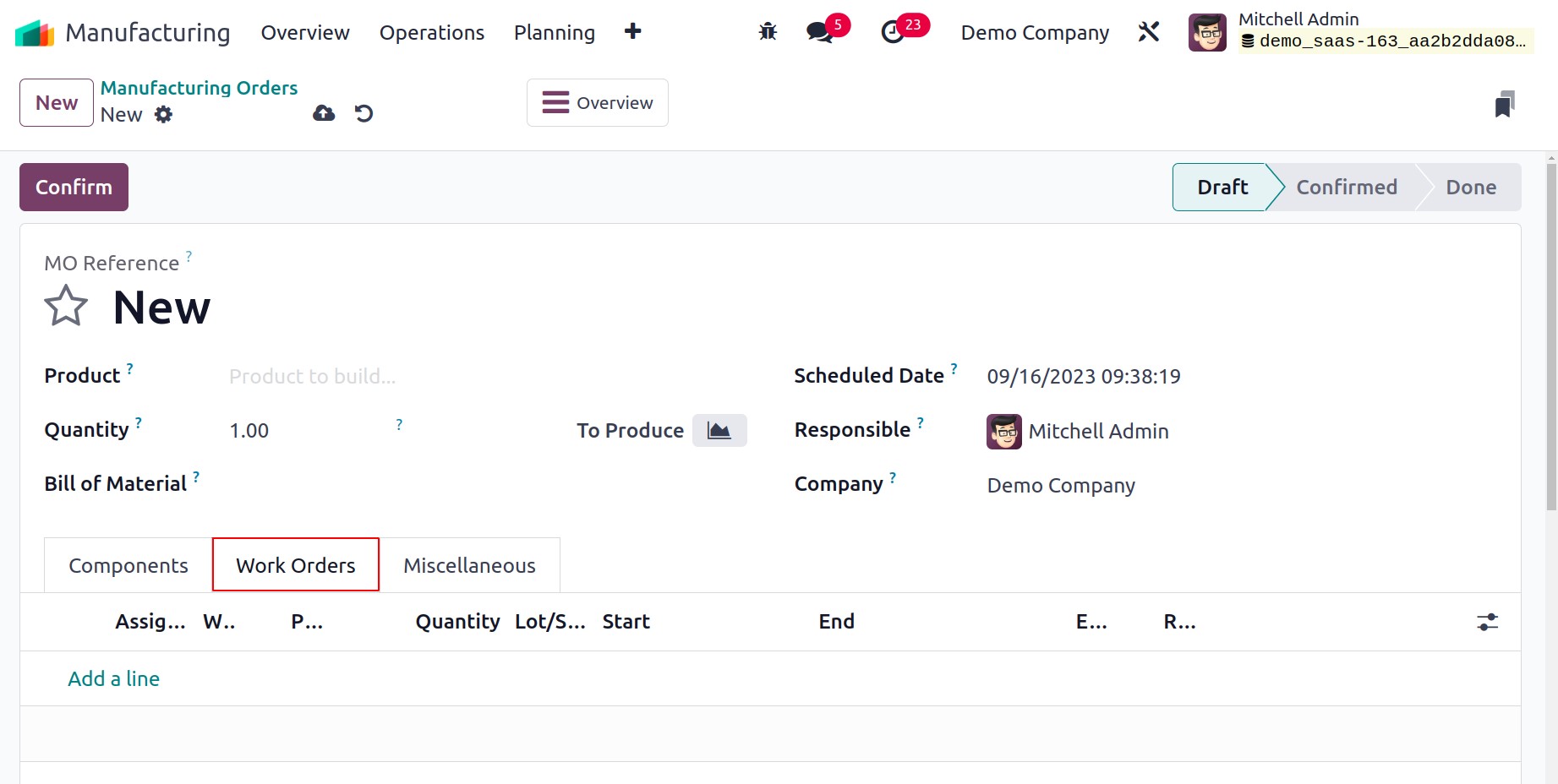
Mention the Operation Type, Components Location (where the product's components are), Finished Product Location (where the system will store the finished product), Source (the document's reference that produced this manufacturing order), and Analytic Account in the Miscellaneous tab. This analytical account will contain the operations cost and consumed items cost entries associated with this manufacturing order.
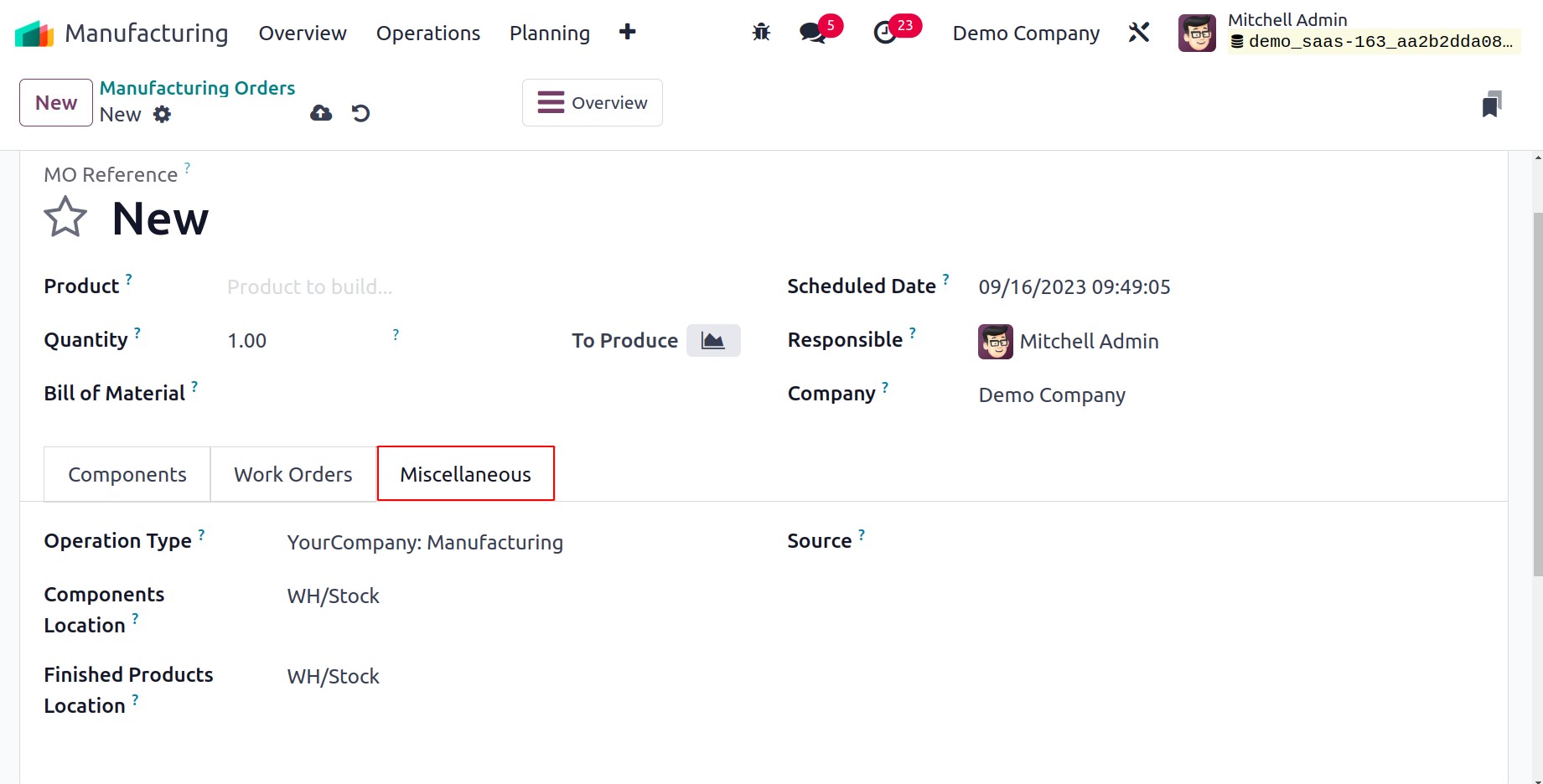
You may occasionally receive some extra products as a result of manufacture. These extra items are regarded as byproducts. You can provide information about the By-products while setting the production order for the primary product. Go to the Settings menu and turn on the By-products option, as seen in the screenshot below, to accomplish this.
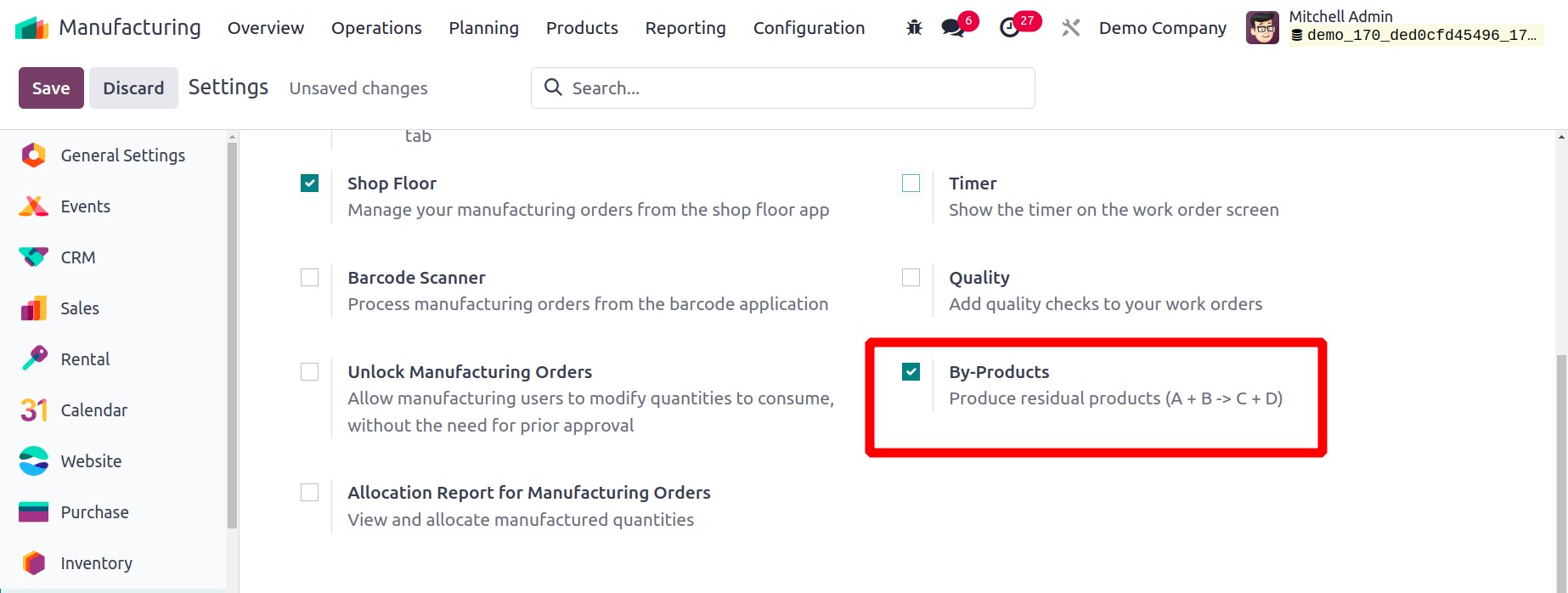
You will be able to access an additional tab in the manufacturing order's form view after you activate this feature. Using the Add a Line option, you can individually identify each of the supplementary products that are included with the primary product here.
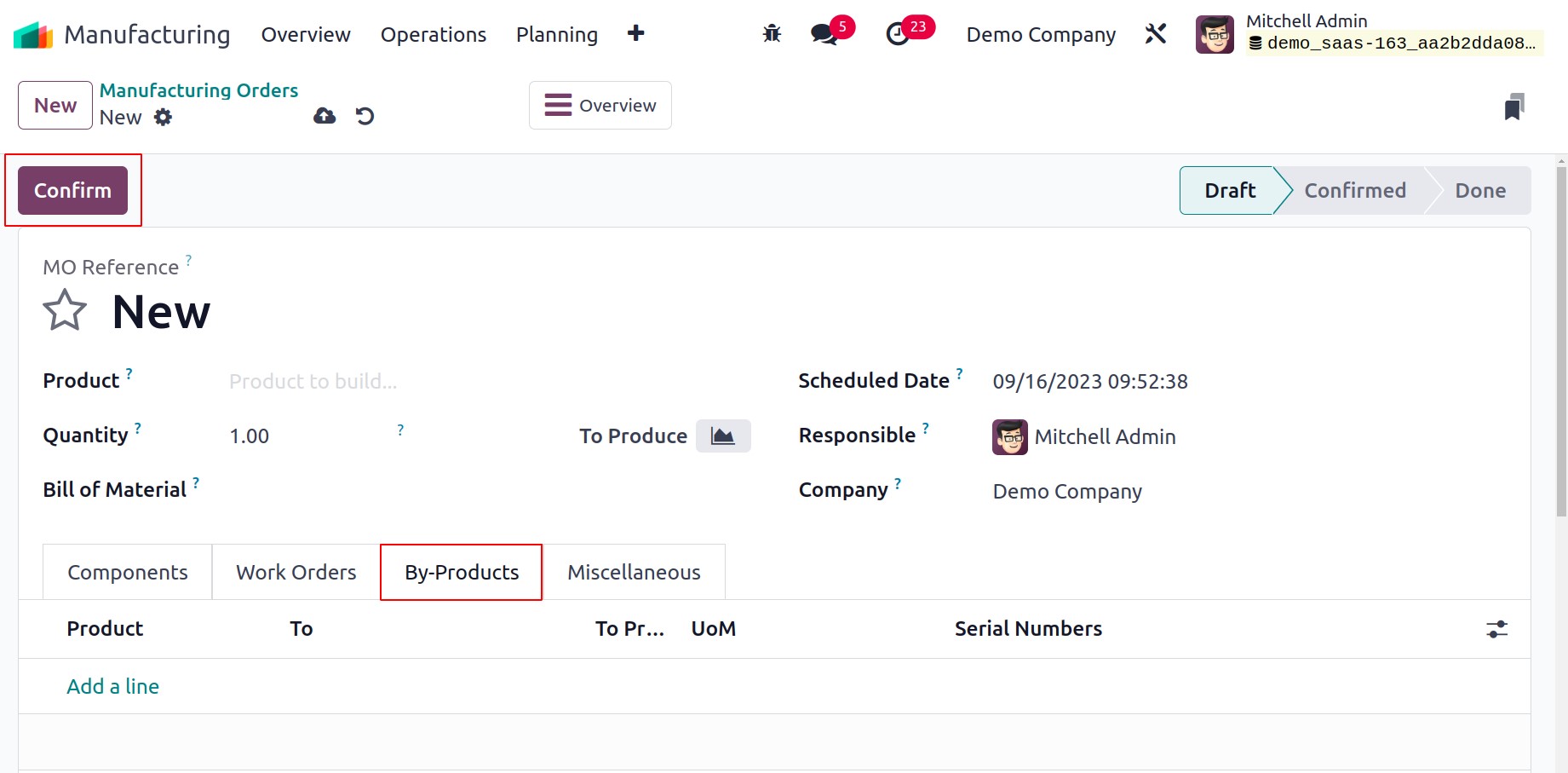
Click the Confirm button after providing all the information required for the manufacturing order.
You can mark the manufacturing order as done by clicking the Plan All option after the manufacture is finished.

Accounting and Business Administration-Advanced Certificate
designed to provide the learners with the required knowledge and hands-on skills needed to compete in the job market.
By creating a Maintenance Request, you can send the created goods to maintenance if you discover any defects. You can create a new maintenance request in a new window by clicking this button. While describing the Maintenance module, we will go through how Odoo17 handles maintenance requests.
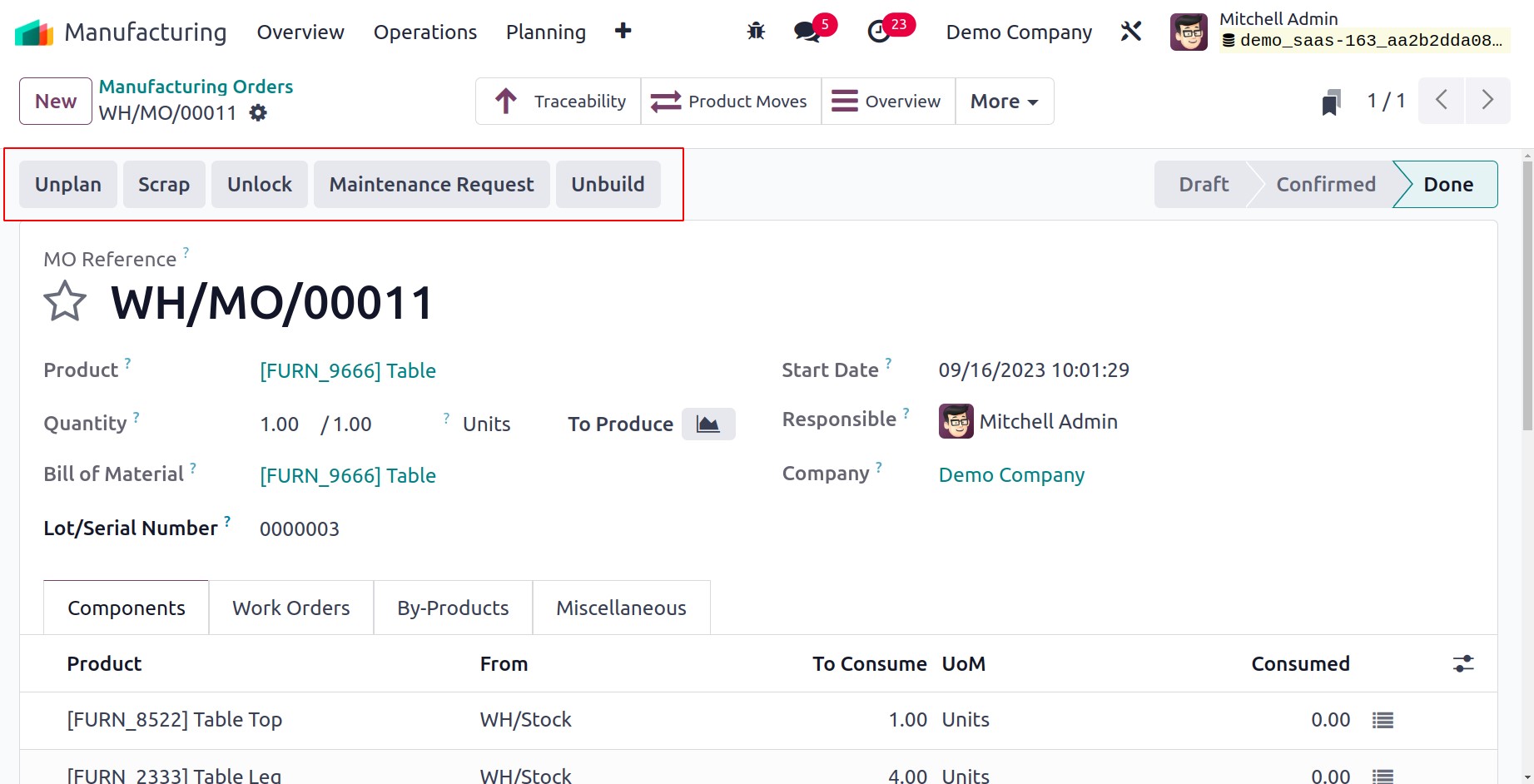
By selecting the Scrap button, you can send the product to the scrap pile if it is wholly ruined. The product, quantity, source location, and scrap location must all be mentioned in the pop-up box that appears. The damaged item will be transferred to the designated scrap location once you click the Validate button.

You may activate the Unlock Manufacturing Orders option in the module's Settings menu. By turning on this option, you can alter your consumption amounts without obtaining previous consent.
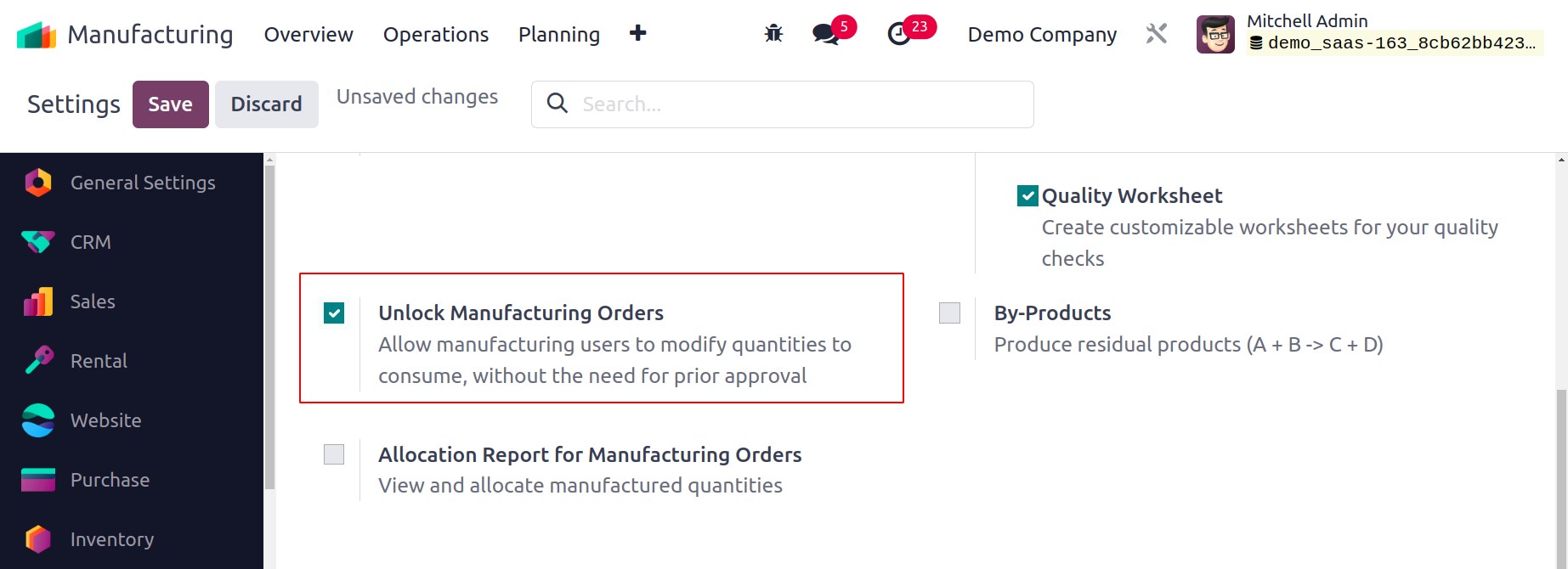
You can adjust the quantities as necessary by clicking the Unlock button. You can unbuild the produced good and log its data by using the Unbuild button.

Here, you must include the quantity of the product to be disassembled. The Source Location field allows you to specify the location of the product you wish to unbuild. You'll decide where to send the components that arise from the unbuild order based on the destination location. Select "Unbuild" from the menu.
In the manufacturing order's form view, there are sophisticated smart buttons that you may use to track different procedures.
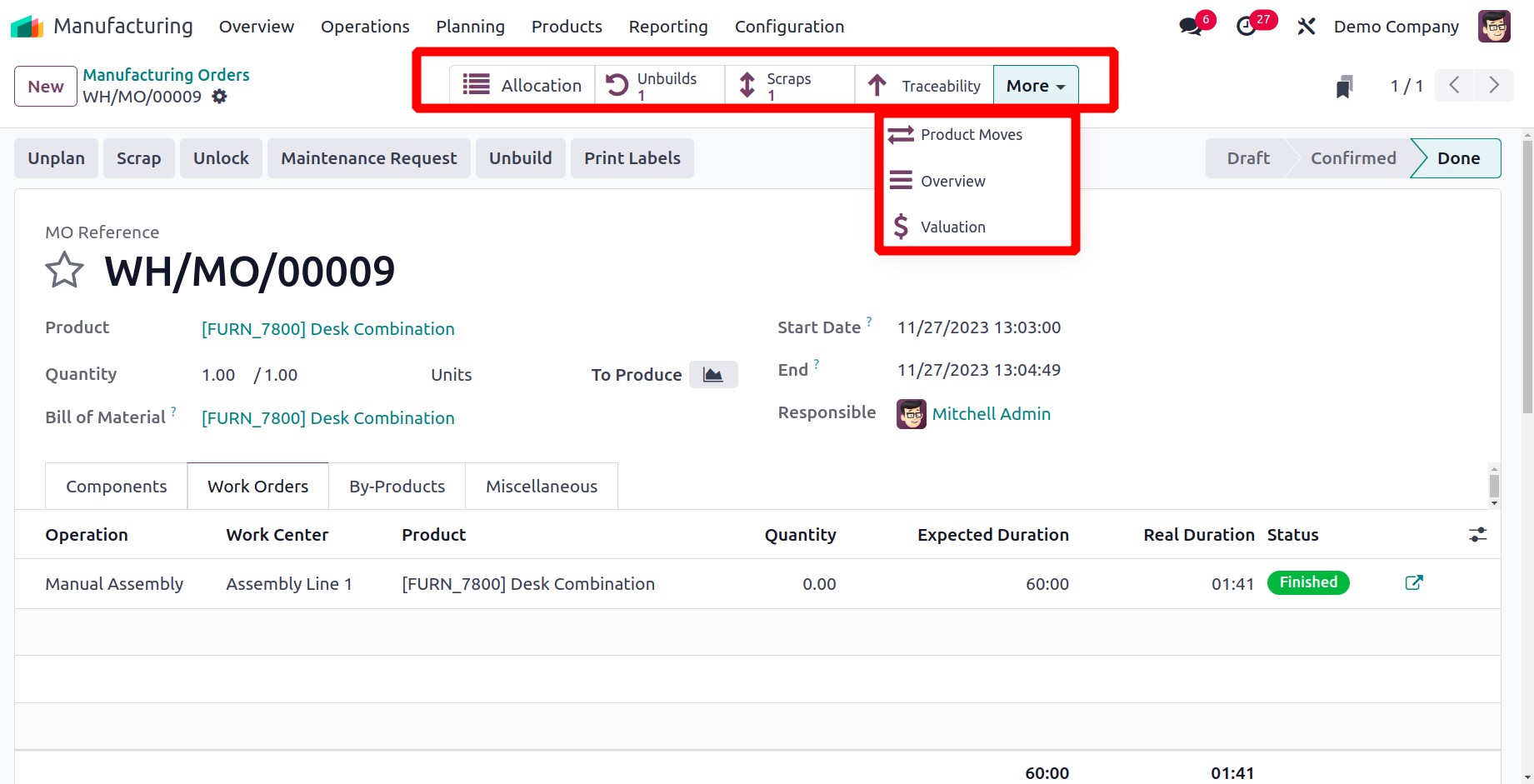
The Allocation button, when clicked, displays the product's Reception Report. You can assign the product to orders using the Assign button.

You can activate the Allocation Report for Manufacturing Orders from the module's Settings menu to receive the Allocation Report for the manufactured amounts. You'll be able to see and assign manufactured goods thanks to this.

The Child MO button allows you to view the manufacturing orders for the main product's constituent parts. Referencing, Scheduled Date, Product, Next Activity, Source, Component Status, Quantity, UoM, Expected Duration, Real Duration, Company, and State are all displayed.
To view the Unbuild Orders, click the Unbuilds button. The reference, product, bill of materials, manufacturing order, lot/serial number, quantity, unit of measurement, source location, company, and status are all displayed in the list of unbuilt orders.

By selecting the Scrap option, you may view the orders for scrap. The pane displays the Reference, Date, Product, Quantity, Unit of Measure, Source Location, Scrap Location, Company, and Status, as seen in the illustration below.

Using the Traceability button, you can create a report detailing the product's traceability. The report displays information on the product's Reference, Product, Date, Lot/Serial, From, To, and Quantity.

The Product Moves button can be used to examine the product's inventory moves. The window displays information about the product and its parts, including the Date, Reference, Product, Lot/Serial Number, From, To, Quantity, Unit, and Status.

By selecting the Valuation button, you may carry out a stock value of the product and its parts. Details about the Date, Reference, Product, Company, Moved Quantity, Unit Value, UoM, and Total Value are provided in the Stock Valuation window.
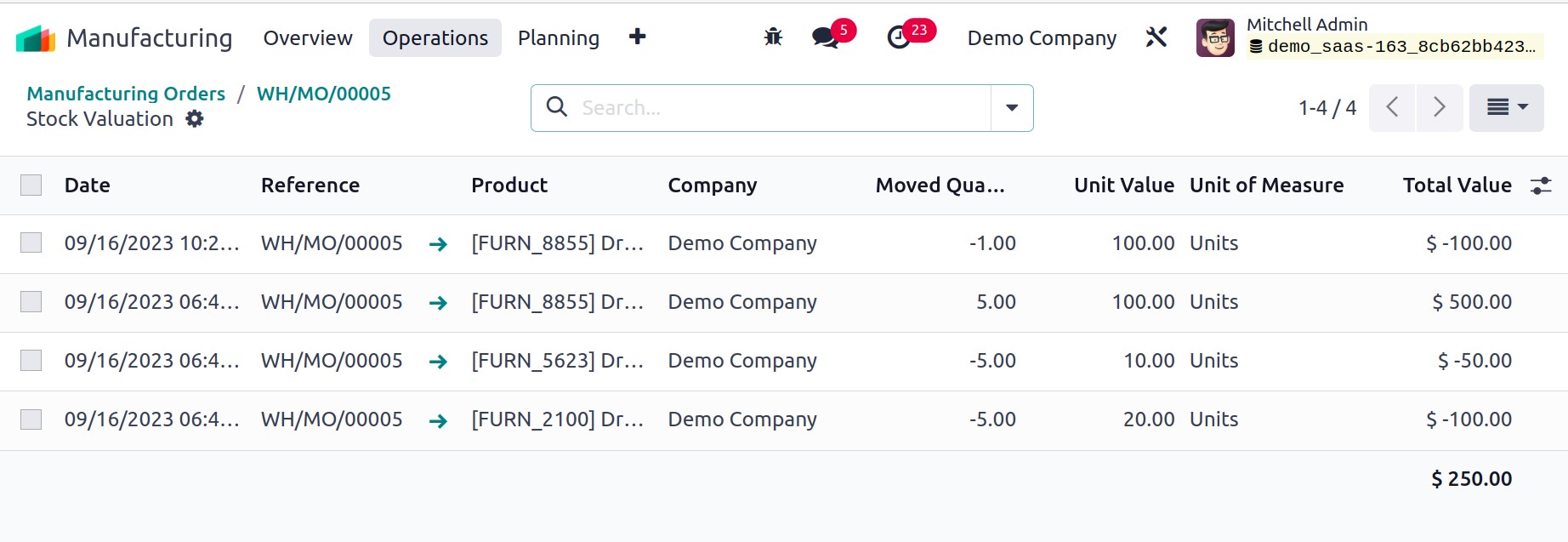
An Overview report will be produced when you click the Overview button, as illustrated below. In this report, you may see the cost of the components and cost of the Operations separately.
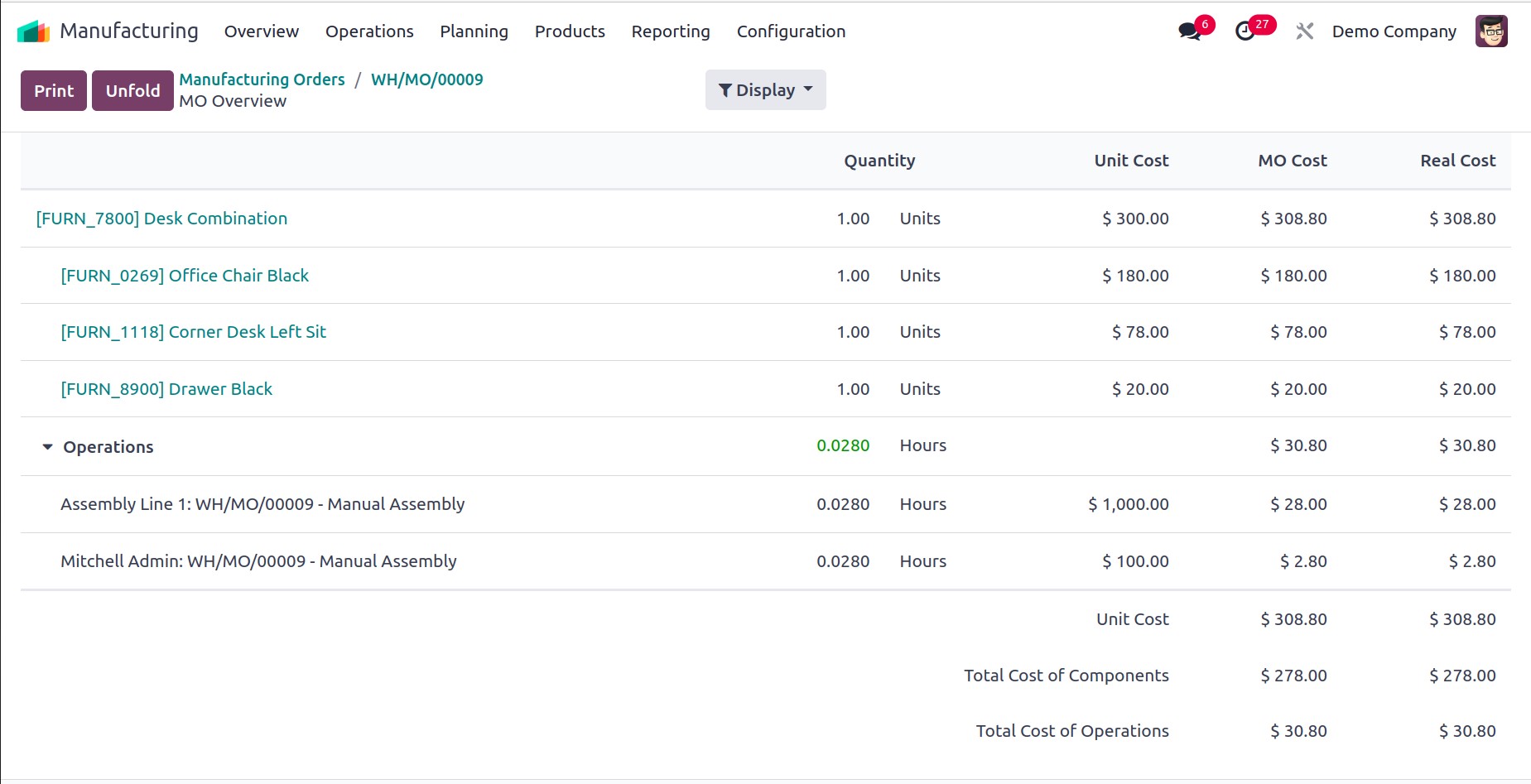
You can find the Security Lead Time function in the Manufacturing module's Settings menu.
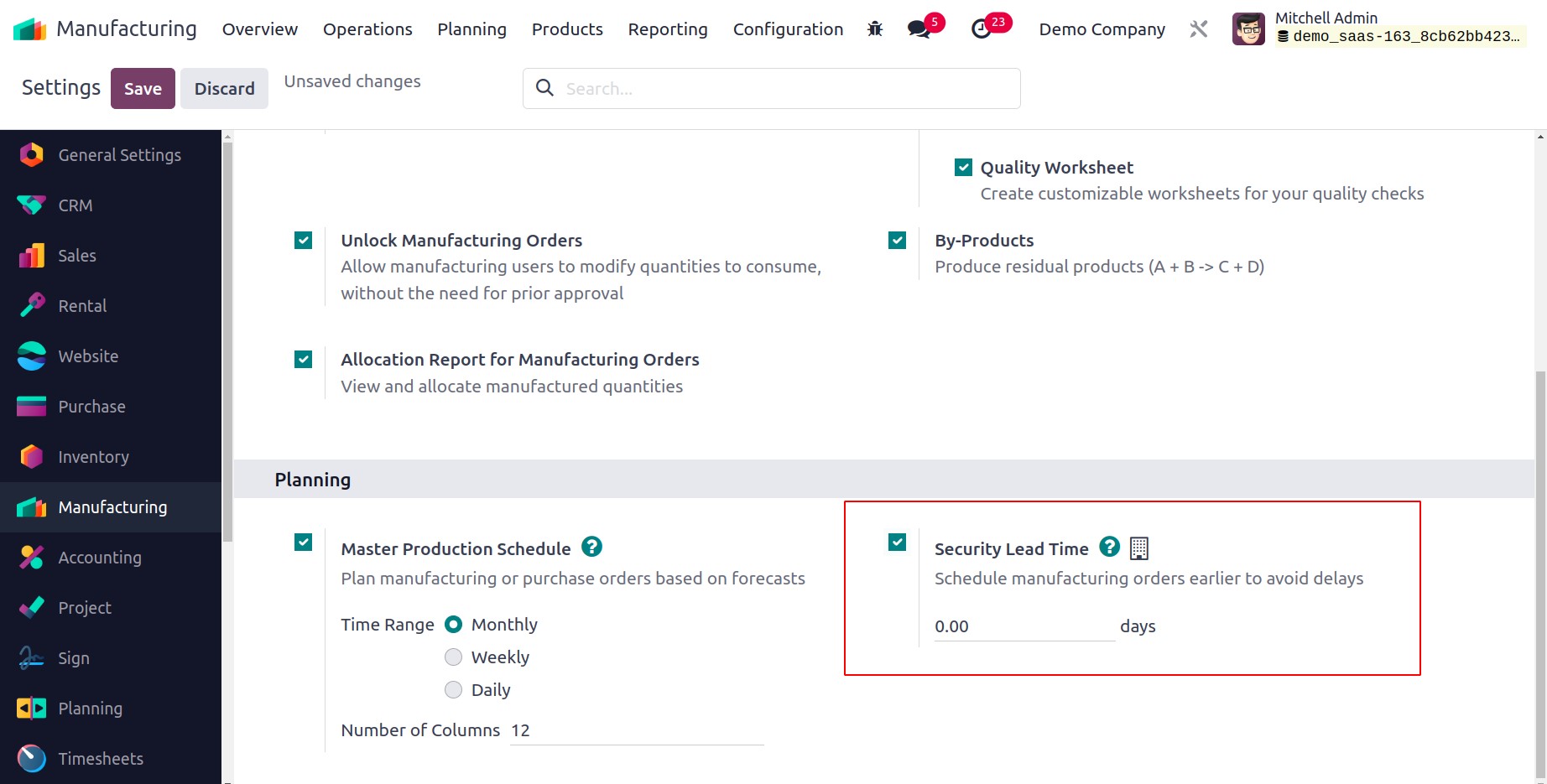
This function can be turned on to arrange production orders for a particular day in advance. In order to avoid delays, the number of days can be specified here, and the manufacturing deadline will be set early.

Discover New Opportunities
In this program, you'll gain the expertise needed to advance you into a senior-level position, manage an accounting department, or pursue an advanced degree in accounting.
for all business, commercial, industrial, government and professional fields. Such training is essential in today’s competitive business environment and a world of increasing international trade and globalisation.
Manufacturing Accounting Explained
Manufacturing accounting deals with all the expenses encountered in making physical goods, which, in any sizable manufacturing business, means an extraordinarily high volume of individual transactions. The accounting process begins by accumulating the costs to buy, hold and use raw materials. It goes on to encompass the costs of direct labor and the production activities that convert raw materials into finished goods. Finally, manufacturing accounting aggregates all of a company’s manufacturing overhead costs and develops a reasonable and systematic way to allocate them to the various products the company makes. All of these component costs are used to value finished goods inventory, which are the products considered ready for immediate sale or stored for future sales.
What’s Different About Manufacturing Accounting?
Unlike the broader discipline of financial accounting, which is charged with reporting all of a business’s activity in financial statements, manufacturing accounting takes a narrower view — it’s limited to the costs incurred during the production process. But that narrow scope does not mean it’s simple. Not only must manufacturing accounting track a high volume of transactions, but it also requires accountants to have a solid understanding of manufacturing operations. Eight other hallmarks of manufacturing accounting are explored here.
Cost Classifications
One of the most fundamental characteristics of manufacturing accounting is proper cost classification. This means identifying and recording, in many separate categories, all of the different costs for direct materials, direct labor and the manufacturing overhead expenses that arise from the production process. Cost classifications are typically embodied by a specialized chart of accounts, so that transactions are categorized appropriately.
Matching Principle
The matching principle is a primary tenet of U.S. Generally Accepted Accounting Principles (GAAP) and International Financial Reporting Standards (IFRS). The matching principle states that an expense should be reflected in the same fiscal period as the revenue it supports. This is a key principle for all GAAP- and IFRS-compliant businesses. But it’s even more important for manufacturers, because they incur significant costs to make a product in advance of selling that product. Without the matching principle, manufacturers would report misleading swings in net income because expenses would be reflected in one fiscal period and revenue in another.
Cost Allocation
Cost allocation is the process of assigning expenses to a particular project or activity. For manufacturers, this involves attributing the various cost categories, like raw materials, to the right finished product. Allocating all manufacturing expenses to the appropriate products helps a business understand its costs, which is the first crucial step in setting sales prices that cover costs and achieve a desired profit.
Inventory Valuation
Inventory is a significant asset on a manufacturer’s balance sheet, so it’s important to value it properly. Manufacturers have three types of inventories: raw materials, finished goods and works in progress. For each type of inventory, there are two factors that impact inventory valuation: the physical count of items and the value of each item. Determining the volume of items involves physically tracking those items through periodic counts and using inventory management software. The inventory valuation process assigns a fully allocated cost to the items, using one of the common valuation methods — first in, first out (FIFO), last in, first out (LIFO), weighted average cost (WAC) or specific identification (SI).
Overhead Allocation
Overhead is a catchall term for all the indirect costs involved in the manufacturing process, such as rent, insurance and taxes for the factory; supporting labor, like factory security personnel; and supplies (and other small components) used to make products. While overhead isn’t as clearly connected to the manufacture of each product as are raw materials, for instance, it can be as significant a cost. Overhead costs are aggregated and then allocated to products for inclusion in the product’s total costs. There are many methods for allocating overhead. In general, manufacturing accountants develop a rate using an appropriate allocation base, such as machine hours or labor hours, to allocate overhead costs.
Work-In-Progress (WIP) Accounting
WIP inventory is one of the three types of inventories included on a company’s balance sheet. WIP covers products that are partially complete — they are no longer just raw materials, yet they aren’t finished goods. This type of inventory presents a unique valuation challenge. Manufacturing accountants typically estimate the value of WIP inventory using the percentage of completion method, which applies an average or standard cost based on the stage of completion. Valuing WIP requires intimate knowledge of the production cycle and can become especially complex when there are multiple batches of many different products.
Variance Analysis
One of the objectives of manufacturing accounting is to provide useful information to measure and monitor the costs of production. Variance analysis, which is the comparison of two data points followed by a qualitative investigation into the difference between them, is one way manufacturing accountants deliver on that objective. It’s common for cost accountants to regularly prepare a package of several variance analyses to give managers a detailed account of how the production process is going. Some examples include comparing planned (budgeted) costs to actual costs, or standard labor hours per unit to actual, or overhead rates in the current period to those incurred in the previous year. Automated reports help save preparation effort, so that more time can be spent probing the variances.
Industry Regulations
Like businesses in other industries, manufacturers must deal with differing sets of regulations from various agencies. The accounting team must stay current on GAAP rules and IRS regulations, both of which are always changing. Many manufacturing companies must comply with GAAP (or IFRS, if outside the U.S.) to satisfy requirements of lenders and investors, or if they are public companies. That requires using accrual-basis accounting for financial statements and adhering to uniform capitalization (UNICAP) rules from the IRS, which, like accrual-basis accounting, requires that overhead costs be capitalized into inventory. Though these rules change fairly often in small ways, significant changes do occur from time to time, such as when UNICAP thresholds were raised as part of the 2017 Tax Cuts and Jobs Act (TCJA). That change gave many more small, private companies the option to use cash-basis accounting, which does not adhere to the matching principle — it simply records revenue and expenses at the time cash is exchanged. That streamlines manufacturing accounting — but also reduces the accuracy of financial reporting.
What Type of Accounting Is Used in Manufacturing?
Manufacturing accounting primarily uses cost accounting to measure and analyze production activity to help managers make decisions. Because cost accounting is intended for an internal company audience, it doesn’t need to adhere strictly to GAAP, so is usually tailored to the unique needs of the business. Cost accounting information is often used in budgets, constraint analysis and margin analysis.
Budgeting [h3]
A budget, of course, is a set of financial documents that shows what a company plans to do in an upcoming fiscal period. It’s the financial manifestation of the company’s strategic plans, so it is built using estimates that are based on historical data, trends, business strategy and predicted demand. Cost accounting provides the data to make reasonable estimates for materials, labor and overhead, which are key components in a manufacturer’s budget.
Constraint Analysis
Just as cost accounting helps manufacturers identify potential issues in their manufacturing process, constraint analysis aims to increase a manufacturer’s output or profitability by analyzing and rectifying any process bottlenecks and limitations. Manufacturing accounting provides data that can help uncover points of rising costs within the production cycle.
Margin Analysis
A manufacturer’s gross margin is one of its most important metrics. Gross margin is the percentage of revenue left over after subtracting COGS. It shows whether the manufacturer is making or losing money, on a direct basis, on every unit it sells. Manufacturing accounting is keenly focused on all elements of COGS, including raw materials, direct labor, supplies, factory overhead and freight-in costs.
Types of Manufacturing Cost
Manufacturing accounting uses a long list of special terms to describe the various types of costs. It can get confusing, but bear in mind that they all reflect different combinations of the three costs of production: raw materials, labor and overhead. Here’s the breakdown.
Total Manufacturing Cost
Total manufacturing cost (TMC) is an inclusive term representing all the costs of producing an item. It is the sum of all the direct and indirect costs inherent in making a finished product.
- Direct costs: Direct costs are those that are tied to producing a specific product, and they fall into two categories: direct materials and direct labor. Direct materials are the components or raw materials that go into the product, such as fabric for clothing, silica for computer chips or lumber for furniture. Direct labor comprises all payroll costs for personnel involved in production of a product, such as a seamstress, carpenter or assembly-line workers. Payroll costs include all compensation for those workers, from wages and overtime to payroll taxes and the employer portions of benefit costs.
- Indirect costs: Also known as manufacturing overhead, indirect costs are all the costs involved in the manufacturing process that aren’t directly traceable to a particular product. Overhead includes supporting manufacturing costs, such as rent, depreciation of production equipment and buildings, real estate taxes for the factory, equipment repairs and factory security. There can be many different indirect manufacturing costs, and their classification can sometimes get fuzzy, such as with supplies that are considered de minimis, or lacking importance, like screws for a furniture manufacturer. In these situations, it’s important to handle them consistently. Indirect costs are aggregated and then allocated to each unit of production, using a standard allocation methodology, since they cannot be directly attributed.
Factory Profit/Loss
Unlike the other metrics discussed in this section, factory profit/loss is a key performance indicator (KPI), not a value used in financial reporting. It helps management assess whether it is more profitable to manufacture a product or purchase it from wholesalers, in whole or in part. The factory profit/loss KPI reflects the difference between an item’s TMC and the market value that a manufacturer would have to pay to buy the item (usually considered its wholesale price). For example, consider a manufacturer that makes a table with a TMC of $10. Alternatively, the company could purchase the table legs for $4 and a tabletop for $8 from a supplier that would preassemble those components. The factory profit would be $2 ([$8 + $4] – $10), because it costs less to manufacture than to buy. Calculating and analyzing factory profit can become much more involved when considering various combinations of building versus purchasing subassemblies.
Accounting and Business Administration-Advanced Certificate
designed to provide the learners with the required knowledge and hands-on skills needed to compete in the job market.
Cost of Goods Manufactured (COGM)
COGM is the total cost of manufacturing the products that are finished during a certain fiscal period, such as a month, quarter or year (although manufacturers can choose to measure it more frequently). It consists of the TMC incurred during the period to produce fully finished goods, plus the net change in WIP inventory, which is the period’s beginning WIP inventory minus its ending WIP inventory. This KPI helps manufacturers identify any anomalies in costs for the period, such as rising materials costs or unusual direct labor overtime. The formula for COGM is:
COGM = TMC for the period + (Beginning WIP – Ending WIP)
OGM = TMC for the period + (Beginning WIP - Ending WIP)
Cost of Goods Sold (COGS)
COGS is a key component of a manufacturer’s income statement that shows the total costs of producing the products that the company sold during the period, including direct materials, direct labor and manufacturing overhead. The key difference between COGS and COGM is that COGS relates to the products sold during a period, using the company’s cost flow assumption, such as FIFO or WAC, while COGM relates to all the products finished during the period. COGS is a critical metric because when deducted from the matching revenue for the period, it shows whether a product has positive gross margins and also influences net income on the income statement.
Variable Costs
Manufacturing costs that fluctuate with production volume are called variable costs. These costs increase as the number of products produced goes up, and they go down when volume decreases. Most direct costs, such as those for materials and hourly labor, tend to be variable costs. Some indirect costs are also variable, like factory utilities that increase as machine hours increase. Understanding variable costs is essential when preparing budgets, forecasts and scenario analyses. Analyzing direct variable costs can help a business squeeze more gross profit from their sales.
Fixed Costs
Fixed costs stay the same, regardless of manufacturing volume. They tend to correlate with the passage of time, rather than activity. Common examples of fixed costs are rent, salaries, insurance and depreciation. A common misconception is that all fixed costs are indirect costs, like factory rent, but there are many examples of fixed costs that are direct costs, such as payment to a salaried seamstress. Manufacturers need to understand fixed costs, because they are obligations that must be met, even if no products are produced.
Costing Methods in Manufacturing Accounting
Manufacturers determine the cost of the products they produce in two steps. First, they accumulate all the production costs, including materials, labor and overhead. Second, they assign those costs to the specific products. There are two approaches to assigning costs — product costing and process costing. A simplified way to contrast these two approaches is to note that product costing tracks specific costs related to a particular product, while process costing aggregates costs incurred at different stages of production. Within these approaches lie several different methods, which are described here.
Standard Costing
Standard costing is a unique type of product costing that uses estimated costs, rather than actual costs, to determine production costs. The estimates, or standards, are based on planned (or budgeted) costs that are then applied to the actual volume of items produced. Using standardized costs reduces tracking effort and, along with it, the cost of bookkeeping. The differences between actual costs and standard costs are captured in variance accounts in the general ledger, which are part of the inventory and COGS balances. Though imprecise at a granular level, standard costing enables business leaders to manage by exception — in other words, to identify significant outliers worthy of deeper investigation.
Job Costing
Job costing is a form of product costing that precisely tracks the cost of making a particular product. This method is used for specific, identifiable jobs, typically those that are customized, one-offs or unique. For example, a custom piece of jewelry might have a “job sheet” that tallies the exact costs of the metals, gems and labor that were used to make it. An amount of factory overhead would be added to calculate the piece’s TMC. Job costing is a very accurate way of costing, but it has limited practical application.
- Job-Order Costing: This is an offshoot of job costing that is typically used when similar goods are produced in batches, rather than as one-offs. The goods within the batch are homogenous, but there may be differences between the batches. A good example is mass-produced furniture, where one batch might include 50,000 lower-cost pine and cotton sofas, while another batch contains 30,000 mahogany and silk sofas. The product costs are tracked by batch, with an average cost assigned to each of the individual products within the batch.
Process Costing
Process costing is an approach that accumulates costs grouped by stage of the production process, rather than by product. It is often used by manufacturers that produce a large volume of identical products, with no significant differences among batches and no need to trace costs by product or batch. Examples of such products include glass, timber, processed food and chemicals. In process costing, department managers are responsible for capturing all the costs and volume that flows through their area, with a focus on calculating the COGM in their section of the process.
Activity-Based Costing (ABC)
ABC costing is a hybrid costing approach. It uses product costing for direct materials and labor, and process costing to allocate indirect costs to products. ABC costing looks at the indirect costs through yet another lens, grouping a company’s overhead costs by activity, rather than by product or department. Some examples of common manufacturing activities are material receiving and inspection, quality assurance, engineering, packing and shipping. Manufacturers can define activities as they see fit for their unique production processes, then collect the costs of each activity in separate “cost pools.” The cost pools are allocated to products based on predetermined metrics that indicate how much of each activity is used to build each product (called cost drivers). The appropriate portion of each activity’s costs is added to the direct materials and labor costs of the product to calculate its TMC. ABC is considered a very precise method of costing, but it is complex to administer.
Inventory Valuation Methods
Once products have been assigned costs, manufacturers select a cost flow assumption for how they will report inventory and COGS. A cost flow assumption is a method of determining which products have been sold during a period and which products remain in inventory at the end of a period. It is an accounting tool to calculate COGS for the period and the value of ending inventory. As such, cost flow assumptions are also called inventory valuation methods. The four main inventory valuation methods are discussed below. It’s important to note that any given company’s cost flow assumption may or may not be aligned with how it picks, packs and ships products to customers — cost flow assumptions are purely accounting tools.
The different methods explained in the following sections can yield very different values for COGS, thereby affecting the manufacturer’s profitability. This is why changing inventory valuation methods from period to period is discouraged by GAAP (and requires additional disclosures) and is prohibited by the IRS without prior approval (to reduce manipulation of taxable income). Therefore, it’s important to understand how each inventory valuation method works and the pros and cons of each, because once a manufacturer selects a method, it is difficult to change.
First-In, First-Out (FIFO)
The FIFO method is an order-of-production approach that assumes the oldest units in inventory are sold first. As such, it also means that the ending inventory on hand would be the units that were most recently manufactured. During inflationary periods, when the cost of raw materials or labor is increasing, the FIFO method yields a higher per-unit value of inventory for those items still on hand, compared with those that were sold earlier in the period. In this case, FIFO would cause COGS to be lower than other methods, which increases profitability.
Last-In, First-Out (LIFO)
LIFO inventory valuation is the reverse of FIFO. It assumes that the newest units produced are sold first and that the inventory on hand at the end of a period consists of the oldest units produced. During periods when costs for raw materials or labor are increasing, LIFO yields a lower per-unit valuation of inventory for those items still on hand, because they were produced earlier in the period. In this case, LIFO would cause COGS to be higher, which causes profits to be lower.
Weighted-Average Cost (WAC)
This method values inventory using an average cost for the period. WAC is calculated by aggregating all the costs incurred and dividing them by total units created over the entire period. The average cost is assigned to every item. This approach is simple to administer and smooths out price fluctuations, usually resulting in COGS that falls between the outcomes from FIFO and LIFO methods.
Specific Identification (SI)
Specific identification is the most accurate inventory valuation method but has limited application. This method tallies the specific costs incurred for each individual item produced. In many ways, it is similar to job-costing. In practice, manufacturers use SI for unique, distinguishable products, such as automobiles, jewelry and construction projects.
Cost-Volume-Profit Analysis (CVP)
Manufacturers need to understand the potential impact that changes in one variable of a product’s business model might have on their overall revenue and profit. As its name implies, CVP is an analytical technique that aims to provide such understanding by combining multiple formulas as needed to perform different “what-if” analyses. For example, CVP analysis can show the effect of changes in a product’s sales volume on the business’s total costs, revenue and income. Manufacturing accountants use CVP to help inform operating decisions, such as whether to increase production, change prices or adjust the product mix.
While there are volumes written about how to perform CVP, understanding a few basics, such as break-even, contribution and margin of safety, can help frame its use for pricing and production decisions.
Break-Even Analysis
A break-even analysis is a common first step in CVP because it helps businesses understand the level at which the revenue from an activity covers its cost. By calculating the break-even point, businesses identify the exact volume of activity that yields no profit and no loss — it is profit neutral. That’s helpful information when deciding whether to launch a new product or business or add additional costs, like hiring more staff. Doing a break-even analysis requires knowing — or estimating — the company’s fixed costs, the variable costs of the activity, the sales price of the resulting product and the volume of expected product sales. The formula for a break-even analysis is:
Break-even point (units) = Fixed costs / (Price per unit - Variable costs per unit)
Contribution Margin
A product’s contribution margin is essential for CVP and break-even analysis. Contribution margin is the amount of revenue that is left over after deducting all the variable costs of an item or activity. It is called the contribution because it’s the amount of funds available to “contribute” to covering fixed expenses. When contribution margin is greater than fixed expenses, the residual is profit. Contribution margin is equal to fixed costs at the break-even point. The formula is, simply:
Contribution margin = Sales - Variable costs
Safety Margin
The margin of safety is the company’s “wiggle room” — the difference between actual sales of a product and its break-even point: in other words, the degree to which sales of a product can fall without the company losing money. The formula is:
Safety margin = Actual sales - Sales at the break-even point
Importance in Pricing and Production Decisions
CVP, break-even and contribution margin are critical metrics that help inform many operating decisions, especially around pricing and production. Financial analysts can use CVP to model what changes in sales prices might do to a company’s profitability, assuming that volume remains the same. Looking at a product’s contribution margin is a quick and direct way of understanding whether a product’s sales price is adequate to cover its variable costs. For example, if a product’s contribution margin is negative, a company is effectively losing money on every item it produces, alerting management that changes are necessary (such as increasing the price or cutting variable costs). Many companies choose a target contribution margin and then reverse-engineer to get to the sales price required to achieve their desired level of profitability. Manufacturers often use CVP to determine whether to increase or decrease production levels. For example, a weak contribution margin may lead to a decision to discontinue a product or to reduce its prominence in the overall product mix. Or, CVP may help indicate whether increasing production could counterbalance a weak contribution margin, assuming there is untapped market demand.
Manufacturing Accounting Challenges
Manufacturing accounting is tedious. It involves a high volume of transactions and tracking — of costs, of products, of inventory — and correlating it all with sales. It also involves aggregating and allocating costs, like factory overhead, in reasonable and consistent ways. And it involves creating and analyzing data to help management keep the factories humming in the most efficient and profitable way possible. Beyond these day-to-day challenges, manufacturing accountants face other overarching challenges from globalization, regulation and advancing technology.
Complexities in Global Operations
Tracking costs for inventory valuation and calculating COGS are high-transaction-volume, painstaking tasks. As manufacturers extend their supply chains and operations internationally, the challenge increases and becomes more complex. Simply getting complete documentation of transactions can become more difficult when dealing with multiple time zones, languages and currencies. Legacy systems often aren’t up to the task of collecting and integrating the necessary data. Timely, accurate information is necessary to stay on top of these tasks, which provide vital support for management decisions.
Changes in Regulations and Standards
Manufacturing accountants need to stay current with accounting and tax guidelines, as well as changing industry regulations and laws. For example, changing accounting rules for leases and recognition of contract revenue are likely to have significant impact on manufacturers’ financial results. A shortage of accountants, especially cost accountants, adds to the challenge. Additionally, regulatory changes from the federal government create more challenges, because they add additional reporting and compliance requirements. In fact, these regulations are such a significant challenge that the National Association of Manufacturers (NAM) tracks the costs of complying with them. A recent NAM study found that the majority of manufacturing companies surveyed spend more than 2,000 labor hours per year complying with various federal regulations. Even small manufacturers incur about $50,000 in expenses per year, per employee, for compliance.
Rapid Technological Advancements
Changing technology is both a challenge and an opportunity for manufacturing accountants. The opportunity derived from additional automation is that tracking manufacturing accounting transactions can become less labor-intensive, allowing for more and better analyses to support decision-making. Additionally, evolving accounting software can make the financial-close process easier and faster, and it can also assist with compliance. However, the current reality for many accounting departments in the manufacturing sector is one of dealing with disconnected legacy systems. Until the infrastructure becomes aligned, manufacturers will be challenged to adopt the latest innovations such as real-time analytics, robotic process automation and artificial intelligence (AI).
Manufacturing Accounting Best Practices
The following seven best practices can help manufacturing accountants as they fulfill their missions to accurately value inventory, determine COGM, calculate COGS and provide custom reports and analyses to help keep the manufacturing processes running as efficiently as possible.
- Choose between cash-basis or accrual accounting ASAP. Select one of the two methods of accounting — if the business qualifies for cash-basis — based on the needs and resources of the organization. Cash-basis accounting is significantly easier to administer and may be an option for businesses that come in under the TCJA 2023 threshold of $29 million in annual revenue for the prior three years (the threshold is adjusted for inflation every year). However, it isn’t GAAP-compliant, which may be a requirement for investors, lenders and partners. For most manufacturers, the default selection will be accrual-basis accounting.
- Create a realistic budget. A thoughtfully constructed budget is more than a blueprint for planned activities and resource allocations — it’s the foundation for comparative analyses that lead to healthier businesses and greater profitability. Comparing actual manufacturing costs to budgeted costs is a useful way to flag variances for further investigation, which can then lead to operational improvements. Budgets also help keep department managers on track for delivering their stages in the production process.
- Keep track of production costs. Establish a system for capturing all production costs by product or batch, as appropriate. This likely means expanding and customizing the chart of accounts, so that all the direct materials, direct labor and manufacturing overhead costs are classified in ways that reflect the reality of a business’s operations.
- Monitor and analyze overhead costs. The indirect costs that make up manufacturing overhead can add up quickly, so it’s a best practice to stay on top of them. This is especially important because overhead costs are usually a diverse mix, from utilities to cleaning supplies to insurance, with many different responsible parties who may not always be aware of the big picture.
- Align accounting with lean manufacturing operations. “Lean” thinking is a management approach that concentrates on improving quality, eliminating waste and increasing customer value, and one that can be applied to any industry. In manufacturing, lean thinking tends to center on maximizing productivity and increasing efficiency. It’s a good idea to rally the accounting team around those goals. That way, they can tailor the information in reports toward lean analyses, ensure that data is updated as frequently as possible and make sure that KPIs and other analyses aim to identify potential inefficiencies and corresponding improvements.
- Implement inventory control. Inventory valuation and control is central to manufacturing accounting. Maintaining real-time counts of physical inventory improves the accuracy of inventory balances, reduces the potential for shrinkage and also helps ensure that stock is available to fill customer orders. Inventory management software preserves the accuracy of quantity data and can be integrated with demand forecasting and accounting software for better and more efficient inventory control.
- Invest in manufacturing software. Handling manufacturing accounting with manual logs and spreadsheets gets unwieldy very quickly, raising the potential for costly errors and misleading financial reports. Modern manufacturing software can make the entire accounting process more accurate and less time-consuming, while providing accountants with better data and the time to do more value-added analysis.
Trends in Manufacturing Accounting
There are several noteworthy trends at the intersection of manufacturing and accounting, but the shortage of accountants is generally cited as a top concern. In 2023, manufacturers face challenges overcoming such talent gaps and labor shortages, even as they wrestle with improving supply chain management and new-technology adoption. Given a backdrop of economic uncertainty following post-pandemic expansion, many manufacturers are more fixated on efficiency than ever before. Three examples of this are the role of technology, lean manufacturing and just-in-time systems.
Role of Technology
For many manufacturers, technology is the tool of choice for doing more with less. Automating repetitive and tedious tasks, whether in the accounting department or on the factory floor, is one way to help fill any labor gaps. For example, tools like enterprise resource planning (ERP) systems can help streamline the manufacturing process from end to end — from order processing through inventory management, production, supply chain, warehouse operations and accounting. At the same time, new technologies, such as artificial intelligence and machine learning, are expected to increase the quality and quantity of data analytics for deeper business insights, leading to higher efficiency.
Lean Manufacturing
Lean manufacturing is a management approach based on five underlying principles: value, value stream, flow, pull and perfection. The value and value stream principles focus on a trio of goals: understanding a product’s import from the customer’s perspective, creating value for the customer and eliminating any waste in the processes that create customer value. The flow and pull principles go hand in hand, as flow is the creation of a smooth process from order to delivery, and pull is the customer demand that triggers the flow. The perfection principle represents the relentless pursuit of increased quality and eradication of defects. Lean manufacturing theory has been around for decades, but today’s advanced technology generates better results than previously possible.
Just-In-Time (JIT) Systems
JIT is an inventory management approach that produces only enough inventory to meet customer demand, eliminating reserve stock. The goal of JIT is to reduce the production costs that come from manufacturing inventory that exceeds immediate levels of demand. Other benefits of JIT are lower carrying costs for inventory, such as storage, security, insurance and shrinkage from theft, damage or obsolescence. Switching to JIT from a “just in case” approach that stockpiles inventory can increase efficiency and profitability. However, JIT comes with risks — it requires precise customer demand forecasting and a highly reliable supply chain.
Simplify and Streamline Manufacturing Accounting Processes With odoo
Manufacturers must understand their costs of production in order to stay in business — it’s table stakes. The nuts and bolts of manufacturing accounting include detailed tracking of costs, ensuring that expenses are properly classified so that inventory and COGS are accurately valued. Sounds simple, but this exercise quickly becomes overwhelming if attempted manually because of the high volume of transactions and all the moving parts. That’s why accounting software is also table stakes, and why it’s so important to choose wisely.
odoo financial management solutions are well suited to manufacturing accounting because they seamlessly integrate all the financial pieces of the production process as part of odoo ERP. From order management to inventory management, accounts payable and accounting, all data is in one central database, reducing the time and risk of duplicated data entry and data inconsistency. With the tedium simplified and streamlined, cost accountants can spend more time analyzing the costs, supported by role-based dashboards and customizable reports, to help drive efficiency and raise profitability.
Manufacturing accounting is a type of managerial accounting that is focused on tracking and analyzing product costs for proper inventory valuation and for optimizing production processes. It uses various costing methods and valuation approaches to capture and allocate all of the various concomitant direct and indirect manufacturing costs. These cost accounting activities and analyses help manufacturing companies maximize profitability and overcome industry challenges. Manufacturing accounting is a big job, in a big industry, and it requires accounting expertise supported by robust technology.
Master of Business Administration Advanced (Accounting)
This course equips you with knowledge and understanding of Business and Administration. You will also achieve Certificate of completions part of the course. At Udemy , we take pride in offering an outstanding educational experience. We are dedicated to helping you achieve your academic and professional aspirations.
Contact us